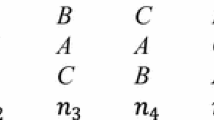Summary
A central political and decision science issue is to understand how election outcomes can change with the choice of a procedure or the slate of candidates. These questions are answered for the important Copeland method (CM) where, with a geometric approach, we characterize all relationships among the rankings of positional voting methods and the CM. Then, we characterize all ways CM rankings can vary as candidates enter or leave the election. In this manner new CM strengths and flaws are detected.
Similar content being viewed by others
References
Condorcet, Marquis de: Essai sur l'application à la possibilité des décisions rendues à la pluralité de voix. Paris: Imprimerie Royale 1785
Copeland, A. H.: A ‘reasonable’ social welfare function, Notes from a seminar on applications of mathematics to the social sciences. University of Michigan 1951
De Grazia, A.: Mathematical derivation of an election system. Isis44, 42–51 (1953)
Merlin, V., Saari, D. G.: The Copeland method. II: Manipulation, monotonicity, and paradoxes. (1994)
Nanson, E. J.: Methods of election. Trans. Proc. R. Soc. Victoria18, 197–240 (1882)
Nurmi, H.: Comparing voting systems. Reidel 1987
Saari, D. G.: Geometry of voting. Berlin: Springer-Verlag 1994
Saari, D. G.: A dictionary for voting paradoxes, Jour. Econ. Theory48, 443–475 (1989)
Saari, D. G.: The Borda dictionary. Soc. Choice Welfare7, 279–317 (1990)
Saari, D. G.: Symmetry extensions of ‘neutrality’, I: Advantage to the Condorcet loser. Soc. Choice Welfare9, 307–336 (1992)
Saari, D. G.: Millions of election rankings from a single profile. Soc. Choice Welfare9, 277–306 (1992)
Saari, D. G.: Relationship admitting families of candidates. Soc. Choice Welfare8, 21–50 (1991)
Saari, D. G.: The source of some paradoxes from social choice and statistics. Jour. Econ. Theory41, 1–22 (1987)
Author information
Authors and Affiliations
Additional information
We would like to thank C. Mount for her careful reading of the manuscript. The work of DG Saari was supported by NSF Grant IRI 9103180. This research was done while V. Merlin was visiting North-western University.
Rights and permissions
About this article
Cite this article
Saari, D.G., Merlin, V.R. The Copeland method. Econ Theory 8, 51–76 (1996). https://doi.org/10.1007/BF01212012
Received:
Issue Date:
DOI: https://doi.org/10.1007/BF01212012




